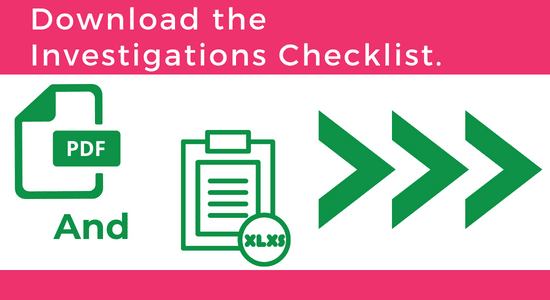
Get our checklist for effective healthcare compliance investigations
Sharon Parsley, JD, MBA, CHC, CHRC, writes a monthly series on compliance officer effectiveness for the YouCompli blog. This is part two of two covering lessons she learned from healthcare compliance investigations that have not gone according to plan. Part one: Make sure you are starting the investigation off right. Part two: Five steps for conducting an effective healthcare compliance investigation.
You have a report that merits investigation, and you have got the people in place to help you investigate. Now what?
Now, you need to plan your investigation, conduct interviews, close out the investigation and follow up. Basic, right? As always, these are nuanced steps. Here are my five steps for conducting an effective healthcare compliance investigation.
1. Develop a healthcare compliance investigation plan and keep it updated.
It is my humble opinion that even a straightforward issue should have a basic plan to keep its investigation on track. If you have a very visible reporting system, chances are you will have numerous matters that require investigation each year. Having a scalable, repeatable process for investigations will help you address each report methodically.
The plan should discretely lay out the issues, name the involved parties, possible witnesses, and investigators, and should have a preliminary target completion timeline attached. As the investigation proceeds, the plan should be adjusted to include subsequently involved persons and actors. The worst of all outcomes is that a reported issue gets the attention of your senior executives, board, the media or a third-party regulator and your documentation of the original investigation does not accurately or adequately demonstrate the good faith efforts to prove or disprove the allegations. Even if you need to backtrack and create or update the investigation plan mid-course or after the fact, it is often time well-spent.
Some investigations seem so unique that they stay with you years later – there are some where I can still recite the facts, findings, and outcomes. They seem so completely one off that you cannot imagine needing documentation of how it played out.
What I have found over time, though, is that the same or similar issue may resurface months or years in the future. If you have well-organized documentation and a solid document retention strategy, you may save yourself or a successor from reinventing the wheel totally the next time a once-in-a-lifetime issue surfaces. If the plan to investigate an issue today is accessible and clear, it might well serve as a benchmark for evaluation of future issues.
2. Consider both retrospective and prospective elements of the healthcare compliance issue.
Many issues take time to evaluate. Say you are dealing with what appears to be an ongoing and systemic billing issue. If there are actions that can be taken today to mitigate future exposure, as well as demonstrate your good faith efforts to quickly mitigate the ongoing issue, discuss and implement game plan to do that. Sometimes, it may just require education or initiating a quality assurance process. Other times though, you may need to have a difficult conversation. You may recommend putting a bill hold in place or suspending a service until the matter can be satisfactorily resolved. Then consider how to scope out and evaluate any retrospective liability that may exist.
3. Be thoughtful about your investigation interviews.
Entire books have been written on the topic of effective workplace interviews. Do not assume that every potential investigator fully understands how to conduct a fact-based interview. Interviewees are often nervous, reactive, and emotional. They may fear retaliation or retribution. Consider whether to make a video or audio recording of the interview and/or whether to include a witness or scribe in the discussion. If it makes sense to do so, accommodate an interviewee’s request to meet at a neutral location or during non-business hours. Particularly in a 24×7 care setting, be respectful of clinical interviewees’ work schedules. Choose a time when they are most likely to be well rested and able to focus without distraction. This might mean offering meeting times outside of normal business hours.
Most importantly, enter every interview with an open mind. It is easy to rush to judgment or conclusion based on the observations of a single interviewee who comes across as honest and trustworthy. Other interviewees who may not be as polished may still have needed valuable information that could dramatically alter your findings and outcomes.
As for the questions themselves, it is not possible to totally script an interview, but you owe it to yourself and the interviewee to be organized and use the time well. When possible, ask open-ended questions. Particularly near the beginning of the interview, it can be useful to get the interviewee to open up and feel comfortable with you. If you do not fully understand a response, ask for clarification until you do. Restate key points and facts and obtain the interviewees acknowledgement that your understanding is complete and accurate.
While there are times when you need to conduct a follow-up interview, do what you can to minimize the likelihood of that by having a prepared list of questions that you need responses to for every planned interview. If an interviewee becomes overly emotional, angry, or disruptive, consider ending the interview and advise the person that you will reschedule it.
4. Plan your compliance investigation documentation and retention methods.
Every full investigation warrants some type of report of findings. In my experience, most of those are narrative style reports or memorandum (even if it is a file memo). For bigger matters, consider having a trusted counterpart or peer review the investigation package and report of findings to see if they can glean an understanding of what the central issues were and what conclusions were reached.
Often, when we are completely immersed in an investigation, the facts are so embedded in our conscious minds that we presume we will always remember them. Take it from one who was once subpoenaed to testify about a matter years after the fact. Your recall of the specifics will dim over time and may be completely lost due to staff turnover, merger or acquisition, or software or system changes.
All that said, the best investigation documentation becomes useless if you are not able to locate it. There are some excellent issue resolution and management tools on the market today, but you have to implement them thoughtfully. Some tools have robust keyword search technology, location and department search and retrieve functions, and involved persons search capabilities. Ensure that whoever enters each matter into that software understands the importance of populating available fields so that future retrieval is quick and easy.
5. Communication, corrective action, and follow-up for healthcare compliance investigations.
Once you have completed your investigation and drawn conclusions about the merit of the allegations, you need to plan to communicate your findings. Findings and recommendations on big issues may be best cascaded top to bottom. Your board and senior executives may need the first briefings on your findings. Next, you will need to discuss the issues with the appropriate operational leaders. Certain issues may be appropriate to review with front-line personnel. When possible, circle back to the reporter to reiterate your appreciation for bringing the issue forward.
You have done most of the arduous work, and perhaps the reported issues were found to have merit. Maybe you need to deploy department-specific or enterprise-wide education or training. Other issues may require policy and process changes involving multiple departments, shifts, and physical locations. Figure out the who, what, when, where, and how. Then document it and track progress toward attainment. Over time, unfortunately, unpleasant habits can resurface. If feasible, your corrective action plan should account for future checkpoints to confirm that the corrective action taken has become hard-wired behavior.
The way you plan for and conduct investigations has a significant effect on the way the organization perceives and relates to the Compliance function. While we hope major investigations will be rare, the day-to-day handling of reports and your responsiveness to hotline calls can help build confidence in your program and in the organization as a whole. Download my checklist for effective healthcare compliance investigations. It can help you lock in a scalable, repeatable process for your investigations.
Download the Healthcare Compliance Investigations Checklist including the action items to consider at each stage of an effective compliance investigation.

Read Five Tips to Start an Investigation Off Right
- A healthcare compliance investigation plan
- Retrospective and prospective elements of the healthcare compliance issue
- Investigation interviews
- Compliance investigation documentation and retention methods
- Communication, corrective action, and follow-up
Effective regulatory change management includes expertise, process, and skills for influence. YouCompli can help with your process – freeing up time for you to focus on relationships, influence, and impact.
Take Free RL3M Assessment (Regulatory Lifecycle Management Maturity Model)
Download our Latest Whitepaper


- One Compliance Pro’s Regulatory Change Management Process
- Five ways to show how healthcare Compliance delivers value
- 12 key metrics for compliance officers looking to…
- Transforming Compliance to a Department of Yes
- Revenue Cycle Management Compliance: Ensuring…
- Three Strategies to Align Compliance with Revenue Cycle
- Navigating Compliance Responsibility: A Foundation…
- Elevate Healthcare Quality Training: Focus, Not Filler
- How the Three Lines Model Strengthens Healthcare Compliance
- Mitigating Conflicts of Interest that Drive Profit…

